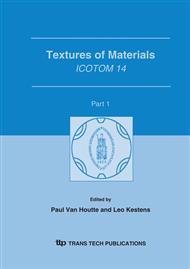p.623
p.633
p.639
p.645
p.651
p.657
p.663
p.669
p.675
Role of Deformation Twinning in Cold Rolling and Recrystallization of Titanium
Abstract:
The evolution of microstructure and texture during cold rolling and recrystallization annealing of commercial-purity Ti (CP-Ti) was established. Cold rolling to 40% reduction activated mechanical twinning- mostly > 3 2 11 < } 2 2 11 { compressive twins and > 1 1 10 < } 2 1 10 { tensile twins. The formation of twins resulted in an inhomogeneous microstructure, in which only the localized regions containing twins were refined and the regions deformed by slip remained coarse. The twinned grains, containing high stored energy and numerous high-angle grain boundaries, became the preferential sites of nucleation during subsequent recrystallization. During recrystallization heat treatment at 500~700°C, the cold-rolling texture (ϕ1=0°, Φ=35°, ϕ2=30°) diminished in intensity, whereas a recrystallization texture component (ϕ1=15°, Φ=35°, ϕ2=35°) appeared. The recrystallization heat treatment temperature affected the rate of recrystallization but not the texture characteristics per se. During the subsequent grain growth stage, the recrystallization texture component increased. This behavior was attributed to the growth of larger-than-average grains of this particular crystal orientation.The evolution of microstructure and texture during cold rolling and recrystallization annealing of commercial-purity Ti (CP-Ti) was established. Cold rolling to 40% reduction activated mechanical twinning- mostly > 3 2 11 < } 2 2 11 { compressive twins and > 1 1 10 < } 2 1 10 { tensile twins. The formation of twins resulted in an inhomogeneous microstructure, in which only the localized regions containing twins were refined and the regions deformed by slip remained coarse. The twinned grains, containing high stored energy and numerous high-angle grain boundaries, became the preferential sites of nucleation during subsequent recrystallization. During recrystallization heat treatment at 500~700°C, the cold-rolling texture (ϕ1=0°, Φ=35°, ϕ2=30°) diminished in intensity, whereas a recrystallization texture component (ϕ1=15°, Φ=35°, ϕ2=35°) appeared. The recrystallization heat treatment temperature affected the rate of recrystallization but not the texture characteristics per se. During the subsequent grain growth stage, the recrystallization texture component increased. This behavior was attributed to the growth of larger-than-average grains of this particular crystal orientation.
Info:
Periodical:
Pages:
651-656
Citation:
Online since:
September 2005
Authors:
Keywords:
Price:
Сopyright:
© 2005 Trans Tech Publications Ltd. All Rights Reserved
Share:
Citation:


